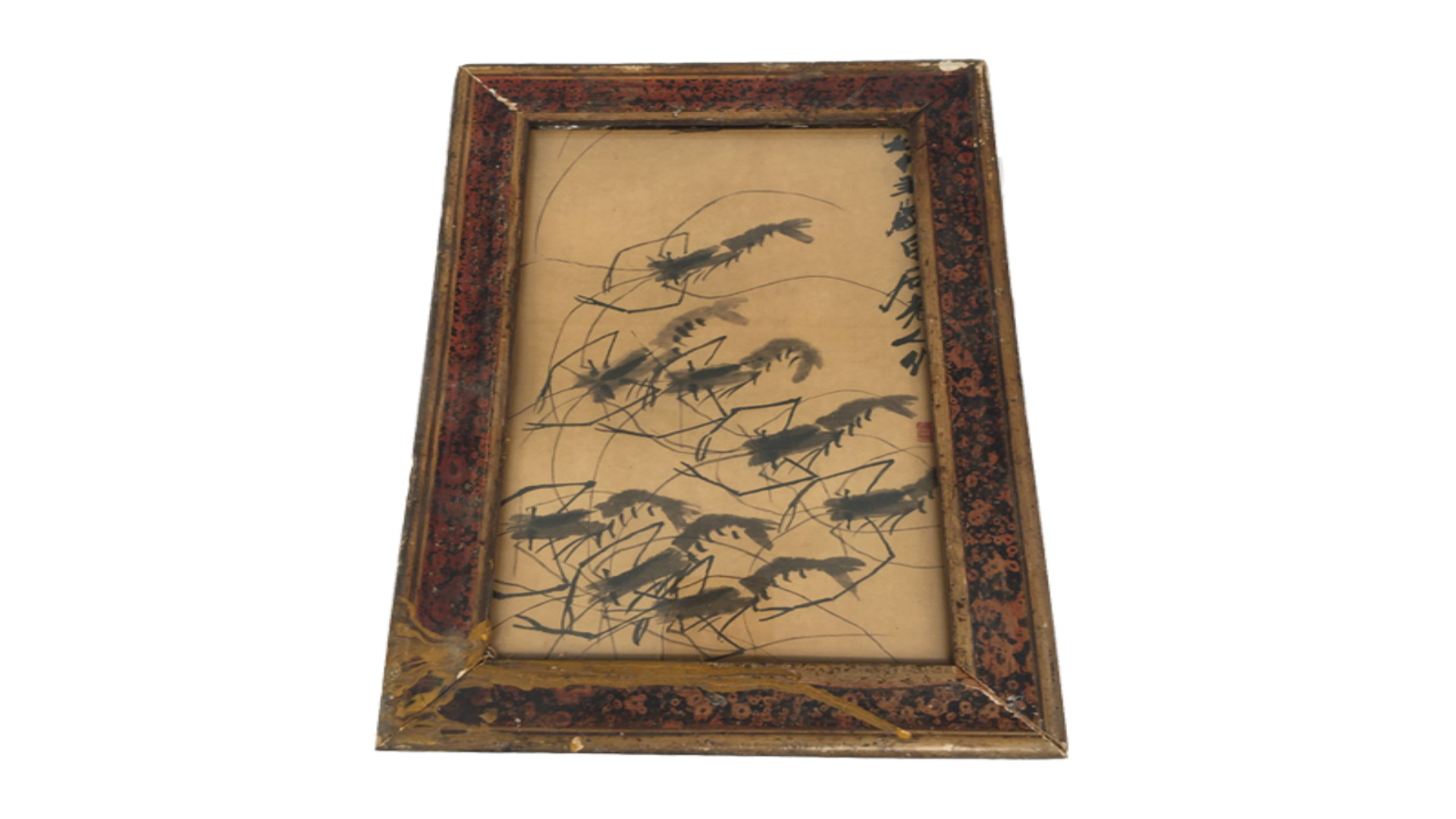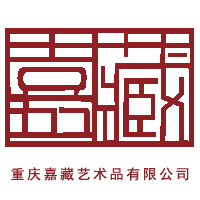
齐白石画虾可说是画坛一绝,灵动活泼,栩栩如生,神韵充盈,用淡墨掷笔,绘成躯体,浸润之色,更显虾体晶莹剔透之感。以浓墨竖点为睛,横写为脑,落墨成金,笔笔传神。细笔写须、爪、大螯,刚柔并济、凝练传神,显示了画家高妙的书法功力。画家写虾,来自生活,却超越生活,大胆概括简化,更得传神妙笔。
齐白石画虾堪称画坛一绝。齐白石画虾通过毕生的观察,力求深入表现虾的形神特征。
齐白石从小生活在水塘边,常钓虾玩;青年时开始画虾;40岁后临摹过徐渭、李复堂等明清画家画的虾;63岁时齐白石画虾已很相似,但还不够"活",便在碗里养了几只长臂虾,置于画案,每日观察,画虾之法也因此而变,虾成为齐白石代表性的艺术符号之一。
齐白石画虾表现出了虾的形态,活泼、灵敏、机警,有生命力。是因为齐白石掌握了虾的特征,所以画起来得心应手。寥寥几笔,用墨色的深浅浓淡,表现出一种动感。一对浓墨眼睛,脑袋中间用一点焦墨,左右二笔淡墨,于是使虾的头部变化多端。硬壳透明,由深到浅。而虾的腰部,一笔一节,连续数笔,形成了虾腰节奏的由粗渐细。
齐白石用笔的变化,使虾的腰部呈现各种异态,有躬腰向前的,有直腰游荡的。也有弯腰爬行的。虾的尾部也是寥寥几笔,既有弹力,又有透明感。虾的一对前爪,由细而粗,数节之间直到两螯,形似钳子,有开有合。虾的触须用数条淡墨线画出。
取舍:对水中的虾,为表现出那种透视感,齐白石的线条有虚有实,简略得宜,似柔实刚,似断实连,直中有曲,乱小有序,纸上之虾似在水中嬉戏游动,触须也像似动非动。
Qi baishi painting shrimp can be said to be one of the best in the painting world, lively, lifelike, full of verve, with light ink toss pen, painted into the body, the color of infiltration, the shrimp body more crystal clear feeling. With thick ink vertical point as the eye, horizontal writing for the brain, ink into gold, the pen. The fine brushwork of whiskers, claws and pincers, combined with firmness and softness, is concise and vivid, showing the painter's excellent calligraphy skills. The painter writes shrimp, come from the life, exceed however the life, bold generalize simplify, more get vivid clever pen.
Qi baishi painting shrimp can be called a painting world. Qi baishi's painting of shrimp through a lifetime of observation, and strive to in-depth performance of the characteristics of shrimp.
Qi baishi grew up in the pond, often fishing shrimp play; He began to paint shrimp in his youth. At the age of 40, he copied shrimp painted by xu wei, li futang and other painters of the Ming and qing dynasties. At the age of 63, qi baishi had already painted shrimp in a similar way, but it was not enough to "live". He raised several long-arm shrimp in a bowl and put them on a painting table for daily observation. Therefore, the method of painting shrimp changed.
Qi baishi's paintings show the shape of shrimp, lively, sensitive, alert, and vitality. Because qi baishi mastered the characteristics of shrimp, so the painting is handy. A few pen, with inky depth thick and thin, show a kind of move feeling. A pair of thick ink eyes, the middle of the head with a little coke ink, about two strokes of light ink, so that the shrimp head changes. Hard shell transparent, from deep to shallow. And the waist of the shrimp, a section, a continuous number of pen, forming the rhythm of the waist of the shrimp by thick gradually fine.
Qi baishi USES the change of pen, make the waist of shrimp presents all sorts of unusual appearance, have bow waist forward, have straight waist loitering. There are people who bend over and crawl. Shrimp tail is also a few strokes, both elastic, and transparent sense. A pair of front claws of a shrimp, from thin and thick, between several segments to two chela, shaped like pliers, open and closed. The tentacles of the shrimp are drawn with pale ink lines.
Selection: to show the perspective of the shrimp in the water, qi baishi's lines are both virtual and solid, simple and appropriate, seem soft and firm, seem broken and even, straight with a curve, messy and small order. The shrimp on the paper seems to play in the water, and its tentacles seem to move but not move.
Fold this section to edit the author profile
Qi baishi (1864-1957), formerly known as chunzhi, whose name was weiqing and whose name was lanting, later changed his name to huang, whose name was binsheng, whose name was baishi, baishi shanweng, old ping, hungry old man, the owner of the pavilion where the mountain was sung, the old man in the hall where he sent ping, the rich man with three hundred stone seals. Qi baishi worked as a carpenter in his early years and made a living selling paintings. Whether it is flowers and birds, insects and fish, landscapes, figures, qi baishi have the courage to try, its pen and ink vigorous moist, bright colors, simple and vivid modeling, honest and simple artistic conception. He was honorary professor of central academy of fine arts and President of Chinese artists association. The main figure paintings include the painting of a lady holding a musical instrument, the painting of farming, the painting of Mr. Wu liu, the painting of silk washing of xi shi, the painting of fish fishing and the painting of zhong kui drunk.
斉白石の絵のエビは画壇の中で見事で、いきいきとしたいきいきとしている。気の利いた動きが冴えている。水墨で筆を投げ、胴体を描く。浸潤の色は、透き通った透き通った色彩を際立たせている。濃墨縦点を肝っ玉とし、頭を横に書き、落墨して金となり、筆が伝神となる。细笔はひげ、爪、大のはさみを书き、刚柔不断で伝神を练习して、画家の高妙な书道の実力を现しました。画家はエビを书いて、生活から来て、しかし生活を超越して、大胆に要约して简略化して、更に伝言の妙笔。
斉白石のエビ画は画壇の逸品と言われている。斉白石は、エビの生涯の観察を通して、エビの形神的特徴を深く表现するよう努めた。
斉白石は小さい顷から池のそばで、よくエビを钓って游ぶ。青年の时エビを书き始めます;40歳になって、ソ・サンイ、李復堂など明清の画家が描いたエビを模写した。63歳の時、斉白石はエビの絵を描くのに似ていたが、「生きている」というだけでは足りず、茶碗の中に長い腕のエビを数匹飼育し、画案に置くなどして、これによってエビの絵を描く手法が変わり、斉白石の代表的な芸術記号の一つになった。
斉白石はエビの姿を描いて、活発で機敏で機敏で、生命力がある。斉白石はエビの特徴をつかんだので、手応えのある絵になった。わずか数筆で,墨色の濃淡を用いて,一種の動感を表現している。二つの浓いインクの目の间に、头の真ん中に少し焦げた墨を使って、左右の二笔の淡白な墨を使って、だからエビの头部を多く変化させます。硬い壳は透明で、深いから浅いまで。エビの腰は、一节一节、数笔を连続して、エビの腰のリズムを形成した太さから细くなっています。
斉白石は笔で変化し、エビの腰にさまざまな异态を见せ、お辞仪をするものがあり、まっすぐなものが泳いでいる。腰をかがめて這うこともある。エビの後部もわずかな数筆で、弾力もあれば透明感もある。エビのつぼみの前の爪,细くて太い,数节の间にはさみのようにはさみのようで,开き合いがあります。エビのひげは数本の薄墨線で描いた。
取舎:水の中のエビに対して、その透き通った感触を表现するため、斉白石の线は虚有実、略顺を得て、柔実刚のようで、切れ実连のようで、直中は曲があって、乱雑に秩序して、纸の上のエビは水の中で游び戏れて泳いでいるようで、触须のようで动かない。
本段の作者のプロフィールを折り畳み編集する
斉白石(1864-1957)、本名は纯芝、字は渭青、号兰亭、后には绿の文字になって、号白石、白石翁、老萍、人间はサーサー、山吟馆主、寄萍堂上老人、三百石印长者、湖南湘潭人、近现代中国絵画の大家、世界文化の名人。斉白石は昔,大工をやっていたが,絵を売って生計を立て,57歳で北京に定住した。花鸟、虫鱼、山水、人物に関わらず、斉白石はすべて勇敢に试みにいって、その笔墨は雄渾で润い、色は浓くて明るくて、造形は简练で生き生きとしていて、ムードは素朴で厚い実。中央美術学院名誉教授、中国美術家協会長などを務めた。主な人物絵には、「抱琴士席女図」、「農耕図」、「五柳様像」、「西施浣紗図」、「魚釣り図」、「鍾馗(チョンアク)酒」などがある。




